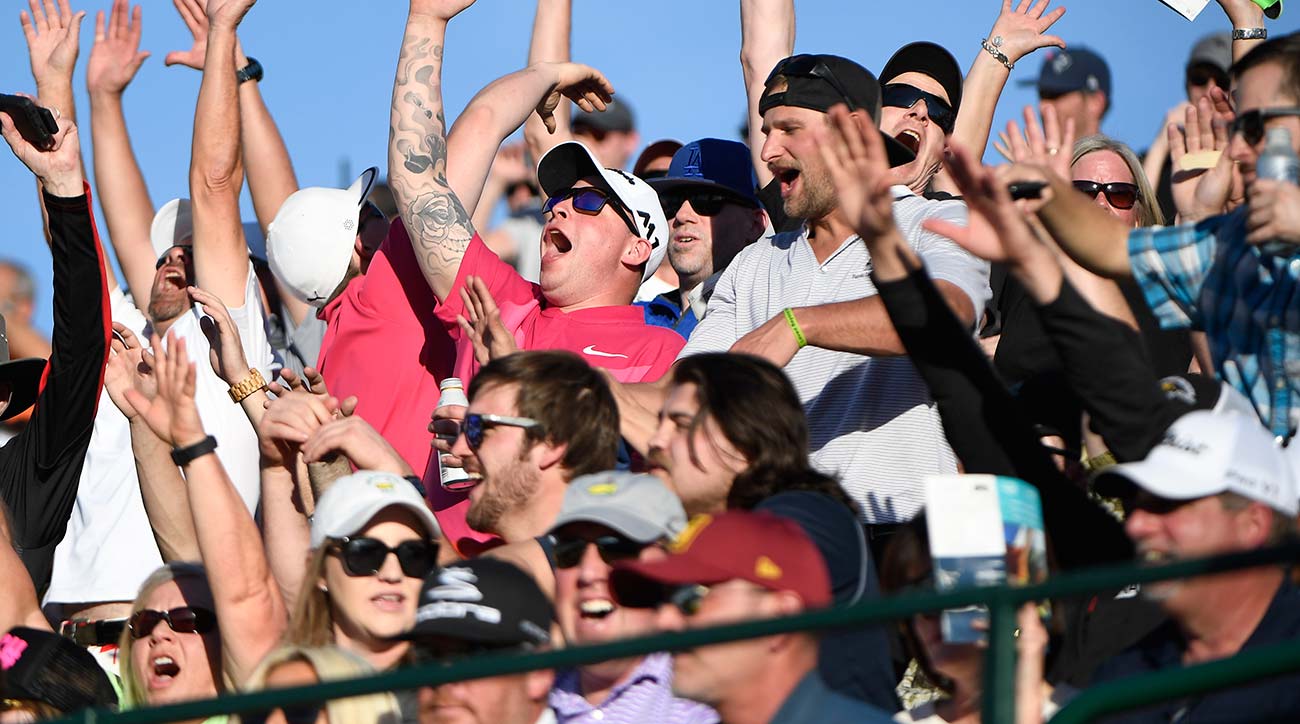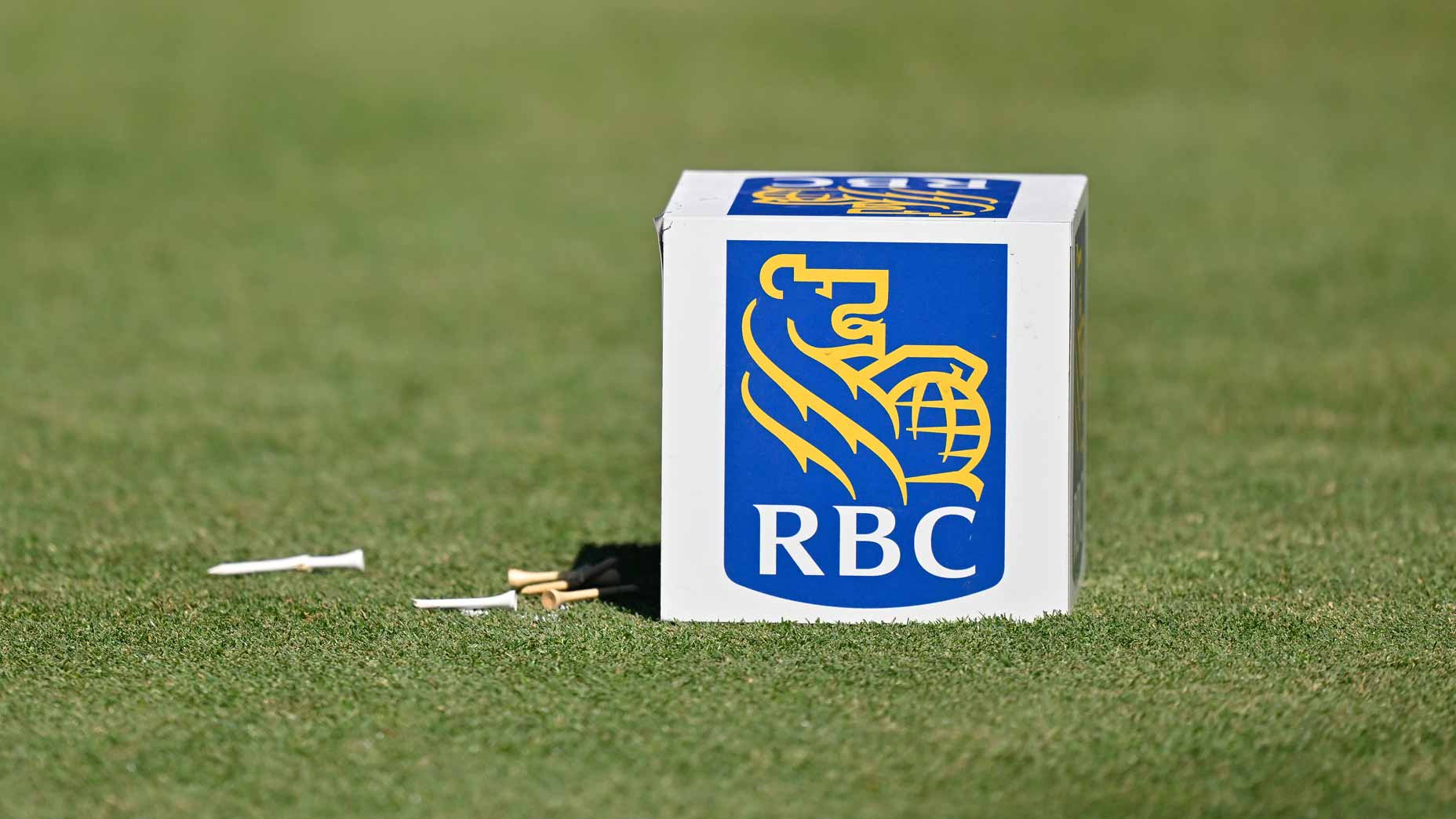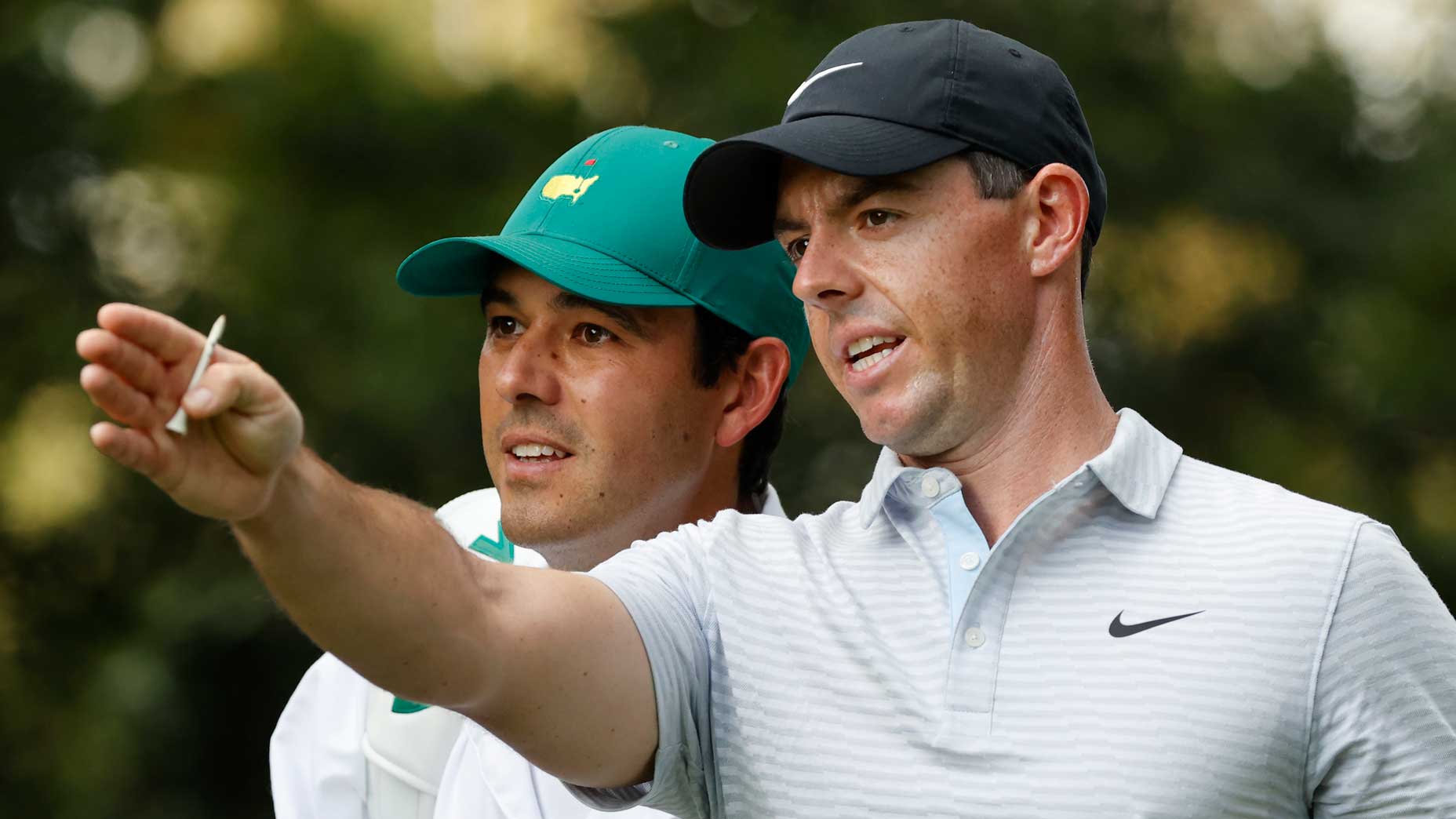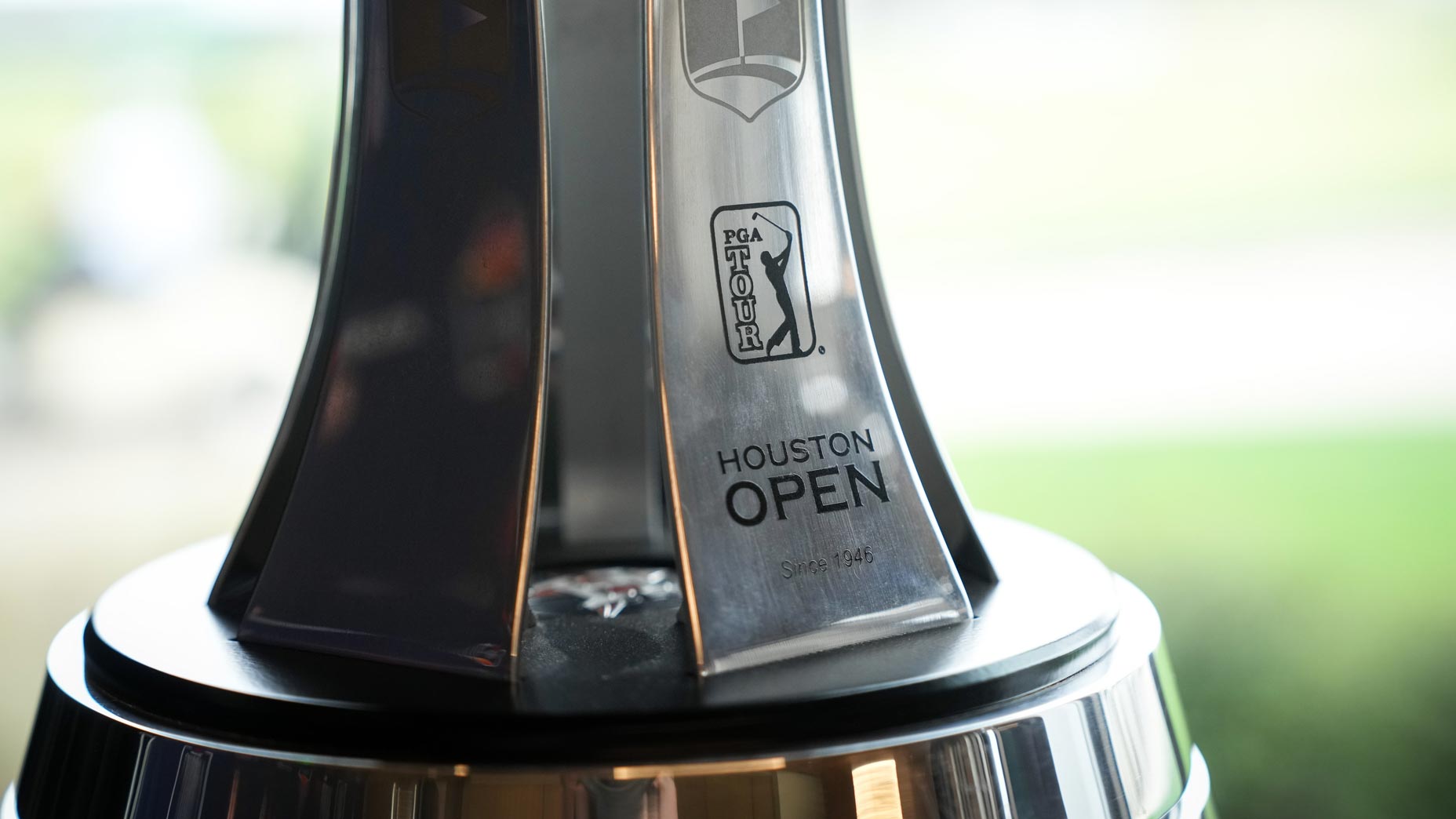GOLF.com conducts a weekly roundtable with writers from Sports Illustrated and GOLF Magazine. Check in every Sunday night for the unfiltered opinions of our writers and editors and join the conversation by tweeting us @golf_com.
1. The rowdiest event in golf was as rowdy as ever. The Waste Management Phoenix Open set attendance records, but not everyone acted accordingly. Jordan Spieth had someone yell during his swing at least twice, Rickie Fowler said he was “disappointed” in some of the things yelled at the par-3 16th and Phil Mickelson, the fan favorite, said that there were so many spectators surrounding him after one wayward drive on Saturday that it was “one of the most uncomfortable moments” he could remember. Have the massive crowds, vocal fans and party atmosphere at the WMPO become untenable?
Alan Shipnuck, senior writer, Sports Illustrated (@AlanShipnuck): As a great Tour philosopher likes to say, It is what it is. The tourney and Tour have encouraged the frat boy vibe so of course there is going to be bad behavior. It will take Phil and Jordan and a bunch of other top players skipping the event before any efforts are made to change things.
Josh Sens, contributing writer, GOLF Magazine (@JoshSens): It only becomes untenable if the pros all decide they’re fed up playing it. Do you think that’s going to happen? But on a broader note about behavior. Yeah, it’s a bummer to see guys get heckled and a lot of the fan comportment at the Waste Management is Darwin Award-dumb. But let’s not pretend that the Waste Management has a monopoly on bad behavior. I don’t have a lot of patience for tut-tutting traditionalists saying the Waste Management is an affront to the blissful way things were. Bad behavior takes a lot of forms and golf has a long history of unseemly behavior happening under a genteel guise. Well-practiced exclusion. Outright discrimination. The PGA Tour used to have a caucasian-only clause. Just last week, at the Farmers Insurance Open, I stood next to a tournament marshal who encouraged the crowd to beat the pulp out of a guy who had yelled in Tiger’s backswing. I don’t condone a yahoo heckling Rickie Fowler or Jordan Spieth or anyone else. But all the self-proclaimed purist harrumphing about the Waste Management isn’t just tedious. It belies a truth. Golf likes to pretend that people who play and love the game are somehow intrinsically more honorable because of it. I don’t buy it. And I believe that people who hang out in glass clubhouses shouldn’t throw stones.
Michael Bamberger, senior writer, Sports Illustrated: Someone will get hurt I fear before the sheriff steps in.
Jeff Ritter, digital development editor, GOLF.com (@Jeff_Ritter): There are bad fans at every Tour stop, but Phoenix is their Carnival. Sens makes some great points, but even if Tour pros turned on this event and called for more decorum, or skipped it entirely, the ship has long since sailed. Perhaps it’s approaching untenable, but it’s hard to look at those record attendance numbers and expect anything to change.
Sean Zak, associate editor, GOLF.com (@sean_zak): It’s the most-attended event on Tour, so the Waste Management Phoenix Open calls the shots themselves. The players don’t here. Sure, the players can speak loudly by not showing up, but the WMPO has wanted this type of setting — or something similar to it — for years. As long as the fans keep coming, paying tickets, buying beer and recycling, the players are going to be somewhat uncomfortable. Don’t like it? Don’t join the field.
Dylan Dethier, associate editor, GOLF.com (@dylan_dethier): I understand the backlash, but the Tour has played into this for years and now gotten exactly what it wanted. Do I think it’s the greatest arena in sports? No. But it’s different, and fun, and exciting. Own it!
John Wood, caddie for Matt Kuchar (@johnwould): By and large, it’s an incredible event. The Waste Management has found their niche and knows what it does best, something more events could try and emulate. That being said, they can do better. While we weren’t in one of the marquee pairings for the first two rounds, you can feel when things are slightly over the top. What I might suggest moving forward is scheduling a security meeting next year with certain players and their caddies on Tuesday afternoon and listening to their concerns and ideas. I’d want to make sure the security personnel knows what is expected, what to look for, and what punishment should be for different actions. Something that’s acceptable during an event in the general public may not be acceptable at a golf tournament, like yelling during Jordan’s swing. The incidents predominantly occur within featured pairings and then for everyone from 15 green to 18 tee. A heavy security presence should be a priority in both areas. You can’t expect volunteer marshals or hired security to handle big incidents or disturbances. It has to be police. So a meeting between, say, Phil, Rickie, Jordan and their respective caddies early in the week might be a good idea.

2. Rickie Fowler held a one-stroke lead heading into the final day of the Phoenix Open, but he shot 73 and tied for 11th. He’s now 1 for 6 in converting 54-hole leads or co-leads in his PGA Tour career. Why can’t Rickie close on Sundays?
Sens: Maybe I’m being soft but I wouldn’t make too much of that stat. It’s hard to win. And it’s not like he was running away with the event going into today. He had a razor-thin lead over a pack of gunners. That he was in the lead at all was impressive in itself, as he didn’t have all facets of his game working in any single round this week. I thought he showed a lot of fight to be where he was.
Ritter: It was a one-shot lead against a bunched leaderboard, so it’s not like he kicked away a sure victory. Nothing clicked on Sunday. But Rickie is becoming a frustrating guy to pull for. He has the four Tour titles and all that charisma, but somehow he leaves you wanting more. I still think that because he puts himself in contention so often, the law of averages will kick in and before long he’ll quickly ring up a few more Ws, including that elusive major. But he still has to go out and do it.
Zak: Rickie was in great shape until one poor tee shot undid his chances. Not going to look too far into this instance of not converting a 54-hole lead, nor his history of those instances either. If he converted his next two tries, you wouldn’t be surprised at all, and he would have moved back to the expected number for his playing ability. He had made 199 strokes through three rounds. Jon Rahm, one of the three best players in the world right now, and Chez Reavie — playing the best golf of his life — had made one more stroke over three rounds. It’s tight. Rickie’s chance of winning had to be around 30%. It didn’t happen. Wait until next time.
Dethier: Zak’s right that it’s a small sample size, but it has been striking watching him look just a little bit off on Sundays. He’s one of the best in the game and he’ll have more chances, but will all this “experience” help or hurt him when he’s got the lead next time? Let’s hope we get a lot of chances to find out.
Shipnuck: I have to disagree with much of the above. We can all agree Fowler is nothing but class and one of the game’s great ambassadors, but he turns 30 this year and we’re well past the point of giving him the benefit of the doubt between the ropes. Simply put, the kid is not a closer. He may learn that elusive skill, but all these missed opportunities only add to the scar tissue. I still go back to a different Phoenix Open: 2010, when Fowler was a flashy rookie. He had a chance to win coming down the stretch but on the par-5 15th hole, with only 210 yards to cover the water, he chose to layup. The ensuing par doomed his chances. Thinking of Fowler’s contemporaries, would Jordan or Rory or JT or DJ or JDay or Koepka lay up in that situation? I sincerely doubt it. That moment said a lot about Fowler.
Bamberger: He’s overrated.
Wood: At the risk of sounding like a broken record, it’s HARD to win. Heck, it’s HARD to get in contention to win. While Rickie’s conversion percentage isn’t what he wants or expects of himself, I suspect it’ll happen, and whatever that switch in his brain is will click on and he’ll realize what works best for him to start converting more. I do know we weren’t asking this question when he shot 61 at the Hero, besting everyone in the field by six shots, which is insane, to win there.
3. Sunday’s Gary Woodland-Chez Reavie showdown was the fourth straight playoff on the PGA Tour. Is this a coincidence or a sign that with the wealth of talent at the top of the game today it is becoming increasingly harder for players to separate themselves from the pack over 72 holes?
Sens: Not a coincidence. See above comment about how hard it is to win.
Ritter: Hard to win, hard to close, hard to separate. Now we need these events to get creative and add more juice to the playoffs. How about two-hole aggregates over the most interesting stretch on the course?
Dethier: It keeps our erstwhile Sunday shift employees working late into the night, but I like it. And yeah, with so many guys so dialed in, the pack at the top is tighter together than ever.
Zak: Frankly, I’ve been surprised we haven’t had more playoffs over that past few years. This is entirely based off self-perception, but we’re wayyyy overdue for a U.S. Open Monday playoff. I know that’s not answering the question here, but that’s what I’m waiting for. This four-week stretch is an anomaly.
Shipnuck: Zak, go to your room, you’re grounded.
Bamberger: Statistical anomaly. But fun.
Wood: I’m frankly surprised there isn’t a playoff every single week. There is such a depth of talent and skill it’s virtually impossible to separate from the field like Tiger used to. But then Tiger was that much better than anyone else. Unless someone gets insanely hot with the putter for the weekend, I’d almost always expect there to be a playoff. I like Jeff’s idea above about getting creative with the playoff format. Two or three holes would be a blast if there’s enough daylight.

4. During the USGA’s annual meeting on Saturday, executive director Mike Davis referenced golf’s distance problem. “We do not think increased distance is good for the game,” Davis said. “We’ve watched these footprints grow. What good has it done?” What should be the No. 1 issue facing the game that the governing bodies should tackle in 2018?
Sens: I’d love to see a limited-distance ball, or at least a few events that employed it. But I realize what a long-shot that is. On a more realistic note, I’d like to see a continued emphasis on picking up the pace of play.
Ritter: Pace of play is big, and if golf can continue to make the rules simpler and easier to understand (rip out white stakes and replace with red, for example), faster speeds will follow. The USGA took some positive steps with their recent rules update. There’s more work to be done.
Zak: Sadly, I’ve played so much New York City golf in the past year that I’m already writing off six hours of time spent at the course. I’d love pace of play to improve, but I think that is far more difficult than bifurcating different equipment standards used for different levels of play. But what do I know.
Bamberger: The No. 1 issue? To support low-cost public golf on courses that are good enough.
Shipnuck: That’s pretty rich by Davis, considering the USGA has been asleep at the wheel as Tour players have gotten so long they’re making a mockery of the game’s traditional playing fields. But I agree with Mike, we need to do more to bring the price point way down to attract and retain new players.
Sens: I’m all for low-cost golf but I live in one of the most expensive cities in the country. Here, as in most cities I’ve been to, you can play a pretty reasonably priced round of golf. $12 bucks gets me a round at a decent muni. $8 to play a very pretty par 3. Maybe there are surveys that prove otherwise, but the time consumed playing golf is a bigger issue than the price. If you want to find affordable golf (like, way cheaper than a lot of forms of entertainment), it’s there. It’s the five hours I personally can’t afford, and I think that’s the case for many people who would otherwise play more.
Dethier: Another striking comment Davis made was that one in four American golf courses is losing money. So, uh, that seems like an issue.
Wood: I think at the most elite level of men’s golf, distance is the No. 1 concern. I won’t go through the number of reasons for this, but the ball and the size of the driver head are the main two reasons. The ball is obvious. Less obvious is the size of the sweet spot on modern drivers. Back in the day, the sweet spot on a persimmon or even early generation metal driver head was the size of as dime. Remember the term, “hitting a ball on the screws?” It meant you made contact on the club’s sweet spot, in between or even on the tiny screws in the face. Well, that sweet spot now is about five times bigger. What’s that mean? Well, it means instead of swinging at a driver at 80 percent most of the time to make solid contact like Jack used to talk about, the modern player goes after a driver at 100 percent almost every time. There is just so much more room for error. Miss an old persimmon driver by half an inch toward the toe and you hit a rope hook. Half an inch toward the heel and you’d lose a ton of yardage, height and control. Today, with the forgiving nature of these massive and brilliantly engineered driver heads, there is virtually no difference between mishits and balls struck “on the screws.” OK, I’m way off topic but yes, at the most elite level, distance is the main concern. Everywhere else? Pace of play.
5. Juli Inkster was announced as the Americans’ Solheim Cup captain for 2019, making it the third straight competition she’ll lead the U.S. A good call, since she is 2-0, or time to give someone else a shot?
Sens: Is anyone complaining about this? This seems like an if-it-ain’t-broke-don’t-mess-with-it situation.
Ritter: She’s unbeaten and with all due respect to Inkster’s assistants at the last two Cups — Pat Hurst, Wendy Ward and Nancy Lopez — I’m not sure they are being groomed for the big job. It’s Inkster’s show.
Zak: The players adore her. She’s great on the microphone. She’s undefeated. Let her captain the next three Cups.
Dethier: I’m down with this, but maybe a three-event term limit? It’s partly an honorary title. Spread the love.
Shipnuck: Yep, it’s a great call. But being Solheim captain is one of the most prestigious accomplishments in women’s golf so I hope lotsa other women will be given that honor.
Bamberger: Fantastic. One of the most underrated players and figures in the game.
Wood: Admittedly writing with a pro-Inkster bias, if I were in charge I’d say, “Ink, let us know when you don’t want the job anymore. Otherwise it’s yours until then.” One of my favorite people in all of golf.
6. The USGA announced that a U.S. Senior Women’s Open is beginning in 2019 and with $1 million in prize money. What other national championship would you like to see the USGA introduce?
Sens: The Waste Management U.S. Open. I dunno. How about a limited-flight ball national championship?
Ritter: I still think some kind of co-ed competition could work. Maybe the Olympics will make a format change and prove my point.
Zak: Give me the U.S. Senior Senior Open for players 80 and older. Gary Player would have two Senior Senior majors by now, wouldn’t he? Unless your sneaky great grandpa stole one from him.
Dethier: All in on the Senior Senior Open. Give the late bloomers a shot!
Shipnuck: I like Ritter’s idea. Start it at the amateur level and it will be such a home run I think we would get a PGA Tour/LPGA event quite quickly.
Bamberger: A national championship for players with fewer than four limbs.
Wood: A professional team championship. Something like the old Dunhill Cup or World Cup. Probably logistically impossible, but a four-person team from each nation would be something I would love to watch.







